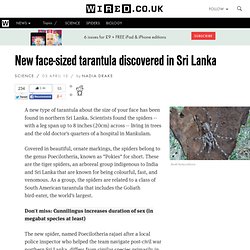

Giant tarantula discovered in Sri Lanka. The newly discovered Poecilotheria rajaei tarantula.

(Ramil Nanayakkara) A large species of tarantula, roughly the size of an adult human face, has been discovered in Sri Lanka. And while the venom of the Poecilotheria rajaei is not lethal to humans, there’s little doubt the abnormal size of the spider could be disturbing, even to those not afflicted with arachnophobia. The spider’s leg span is a reported 8 inches, with researchers comparing its circumference with the size of a dinner plate. It's covered in a variety of colors, including pink, yellow and gray. The tarantula was officially discovered by the British Tarantula Society, proving simultaneously that there are still wondrous creatures waiting to be discovered in the wild and at least one official society dedicated to tarantulas. "It can be quite attractive, unless spiders freak you out," said Peter Kirk, editor of the British Tarantula Society journal, in an interview with the New York Daily News. Living NatureEnvironmentSri Lanka.
Giant Tarantula Discovered: Venomous Sri Lankan Spider Threatened By Deforestation. New species of giant tarantulas with leg span of eight inches discovered in northern Sri Lanka. Ranil P.

Nanayakkara A new species of tarantula about the size of your face has been found in northern Sri Lanka. When a Sri Lanka researcher discovered a new species of tarantula during an arachnid expedition in 2009, he knew it was a big deal — literally. "It was slightly smaller than the size of the plate we have dinner on," Ranil Nanayakkara recalled to the Daily News on Wednesday. Fast, Venomous, Face-Sized Tiger Spider Found in Sri Lanka. Smithsonian reports that Poecilotheria rajaei, a new species of Tiger Spider, has been found in Sri Lanka.

The large spider has a leg span of eight inches. It is also poisonous and very fast. The discovery was reported in the British Tarantula Society journal. You can read the article here. The researchers say, "The spiders of the genus Poecilotheria are known for their large size, colourful markings, their lightening-fast speed and their potent venom. " The spider was discovered by Ranil Nanayakkara and his team of researchers. Wired reports that Robert Raven, an arachnologist and curator at the Queensland Museum in Australia, is not completely convinced yet that the large spider is a new species. This Giant New Tarantula Has an Eight-Inch Leg Span. New face-sized tarantula discovered in Sri Lanka. A new type of tarantula about the size of your face has been found in northern Sri Lanka.

Scientists found the spiders -- with a leg span up to 8 inches (20cm) across -- living in trees and the old doctor's quarters of a hospital in Mankulam. Covered in beautiful, ornate markings, the spiders belong to the genus Poecilotheria, known as "Pokies" for short. These are the tiger spiders, an arboreal group indigenous to India and Sri Lanka that are known for being colourful, fast, and venomous. As a group, the spiders are related to a class of South American tarantula that includes the Goliath bird-eater, the world's largest.
Don't miss: Cunnilingus increases duration of sex (in megabat species at least) A new species of Tiger Spider, Genus Poecilotheria, from Northern Sri Lanka. Poecilotheria fasciata (colony) - feeding / Fütterung HD. Giant tarantula as big as human face discovered in Sri Lanka. Poecilotheria genus. Giant tarantula as big as human face discovered in Sri Lanka. Scientists have discovered a new species of tiger spider living in northern Sri Lanka.

Scientists have found a new species of tarantula as large as the average human face. Ranil Nanayakkara and his colleagues discovered Poecilotheria rajaei, a new species of tiger spider, in northern Sri Lanka. It was first noticed in 2009, when villagers brought a spider they had killed to researchers. "Days of extensive searching in every tree hole and bark peel were rewarded with a female and to our satisfaction several juveniles too," Nanayakkara and his colleagues said in a study about the spiders published in the British Tarantula Society Journal. P. rajaei was named after a police inspector, Puraja, who helped the researchers locate the spider. British Tarantula Society Journal study While examining the spider, the researchers noticed it didn't look quite like any of the other tiger spiders known to live in Sri Lanka because of its markings and "other significant differences. " Giant tarantula that ‘stings like a bee’ part of north’s peace dividend.
View(s): By Malaka Rodrigo A tarantula almost as big as a dinner plate has been discovered in northern Sri Lanka by a team of researchers who named it after a keen police officer who helped track down live specimens of the giant spider.

The researchers fortuitously happened to be in Mankulam, conducting an island-wide tarantula survey, when a local villager gave them the tarantula he had just killed – a species then unknown to science. The spider is a smaller member of the Bird-Eating Tarantula sub-species found in South America that can kill animals as large as lizards, mice, birds and small snakes.
Lead researcher Ranil Nanayakkara said his team needed to find live specimens, preferably females and juveniles, to establish whether the Mankulam spider was indeed a species new to science by the researchers. His team had to comb pockets of jungles in the area, searching every single tree hole and bark peel that could possibly house this elusive species. Mr. Prof. Giant new tarantula species discovered. British Tarantula Society - Welcome. Tarantula. Overview[edit] Tarantulas sizes range from as small as a fingernail to as large as a dinner plate when the legs are fully extended.

Depending on the species, the body length of tarantulas ranges from 2.5 to 10 centimetres (1 to 4 in), with leg spans of 8–30-centimetre (3–12 in). Leg span is determined by measuring from the tip of the back leg to the tip of the front leg on the opposite side. Some of the largest species of tarantula may weigh over 85 grams (3 oz); the largest of all, the goliath birdeater (Theraphosa blondi) from Venezuela and Brazil, has been reported to attain a weight of 150 grams (5.3 oz) and a leg-span of up to 30 centimetres (12 in), males being the longer and females greater in girth. Theraphosa apophysis (the pinkfoot goliath) was described 187 years after the goliath birdeater; therefore its characteristics are not as well attested.Theraphosa blondi is generally thought to be the heaviest tarantula, and T. apophysis to have the greatest leg span.
Etymology[edit] Poecilotheria. Species[edit] Poecilotheria fasciata (Latreille, 1804) — Sri LankaPoecilotheria formosa Pocock, 1899 — IndiaPoecilotheria hanumavilasumica Smith, 2004 — IndiaPoecilotheria metallica Pocock, 1899 — IndiaPoecilotheria miranda Pocock, 1900 — IndiaPoecilotheria nallamalaiensis Rao et al., 2006 — IndiaPoecilotheria ornata Pocock, 1899 — Sri LankaPoecilotheria pederseni Kirk, 2001 — Sri LankaPoecilotheria pococki Charpentier, 1996 — Sri LankaPoecilotheria rajaei Nanayakkara, et al., 2012 — Sri LankaPoecilotheria regalis Pocock, 1899 — IndiaPoecilotheria rufilata Pocock, 1899 — IndiaPoecilotheria smithi Kirk, 1996 — Sri LankaPoecilotheria striata Pocock, 1895 — IndiaPoecilotheria subfusca Pocock, 1895 — Sri LankaPoecilotheria tigrinawesseli Smith, 2006 — IndiaPoecilotheria uniformis Strand, 1913 — Sri Lanka Poecilotheria pederseni is now Poecilotheria vittata: mf vittata Pocock, 1895....................India, Sri Lanka [1] P. v.

Pocock, 1895a: 172 (Dm). New Species[edit] Recently[when?]